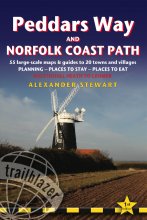I've said it before and I'll say it again, Trailblazer guides take some beating.
— Adventure Travel

Peddars Way and Norfolk Coast Path
Excerpt:
Introduction
Contents | Introduction | About the Peddars Way & Norfolk Coast Path | Practical information for the walker | Itineraries | Using this guide | Sample route guide: Knettishall Heath to Little Cressingham
INTRODUCTION
In that country of luminous landscapes and wide horizons where the wind runs in the reeds
and the slow rivers flow to our cold sea, a man may still sense and live something of the
older England which was uninhabited, free and natural.
Alan Savory, Norfolk Fowler
On the surface, the Peddars Way and Norfolk Coast Path seem unlikely com-
panion routes. One is an ancient ‘dry’ route to the shoreline whilst the other is
a more modern trail vulnerable to the vagaries of the North Sea. However, this
marriage of convenience results in one of the most straightforward and enjoy-
able National Trails to walk.
It was Noel Coward in Private Lives who labelled Norfolk ‘very flat’, dis-
missing at a stroke Britain’s fifth largest county as being rather dull. True, this
is a peaceful, undramatic countryside without mountain ranges, valleys or major
towns, yet it is littered with picturesque villages and is full of subtle charms.
Heading north across the historic landscape there’s time to ponder the
bewildering notion that the Romans who constructed the Peddars Way were far
from the first to pass this way. Even then the route from Knettishall Heath to the
coast, from the forested Suffolk–Norfolk border to the sea, was an ancient high-
way, a safe, dry chalk ridge above the treacherous mudflats, fens and marshes.
There is a lazy roll to the fields and farmland, nothing too taxing for your lungs
or legs, but enough to change the perspective thus concealing a windmill or
church tower, hiding the remnants of Neolithic and Bronze Age civilisations,
and delaying tantalising glimpses of the coast. This section of Norfolk has
always had a raw deal and is rarely thought of in the same light as its more
celebrated northern neighbour. As a result it is quieter and emptier, but no less
magical. The landscape around Little Cressingham, Castle Acre and Sedgeford
is frequently underrated but if you are willing to forgo a few urban pleasures for
a couple of days this timeless stretch of Norfolk is very rewarding.
Dog-legs in the notoriously straight Roman road near Ringstead lead to the
sea, where there is an unassuming meeting of the two paths at Holme. Nothing
prepares you for the scale and beauty of the North Norfolk coast. From here on
the Coast Path bears east and you enjoy brisk head-up walking over beach,
bunker and boardwalk, through fragile dunes and past salt-marshes, crumbling
cliffs, and creeks of fast-filling, fast-emptying tidal water. Along this stretch
there is a constant blurring of sea, salt, sand and sky, but rather than making the
area too similar the coastline has an ever-changing beauty.
The western half of the coast path enjoys vast expanses of beach and dunes
with plenty of sand and space between amenities, whilst the eastern end is a
little tamer and tidier, with the sand succumbing to shingle and traditional fish-
ing communities giving way to the charms of faded Victorian seaside towns
such as Wells, Sheringham and finally Cromer. Nonetheless there are still some
unmissable villages such as Stiffkey, Morston, Blakeney and Cley containing
little more than a glorious church and a cluster of cottages centred on a pub serving
outstanding food and local real ale, as well as some of the best nature reserves
and wildlife or bird-spotting sites in the country.
This is a walk to saunter along and savour in every respect; the many gastro
pubs and restaurants boast some of the finest, freshest ingredients that Britain
has to offer. Ecclesiastical remains all along the route are indicative of the
wealth and status the region once enjoyed; the churches built on the profits of a
thriving medieval wool trade are almost always worth a visit as are the grand
Palladian-style houses. Spend time exploring this landscape with its simple
lines and succumb to its many and varied charms.
Latest tweets